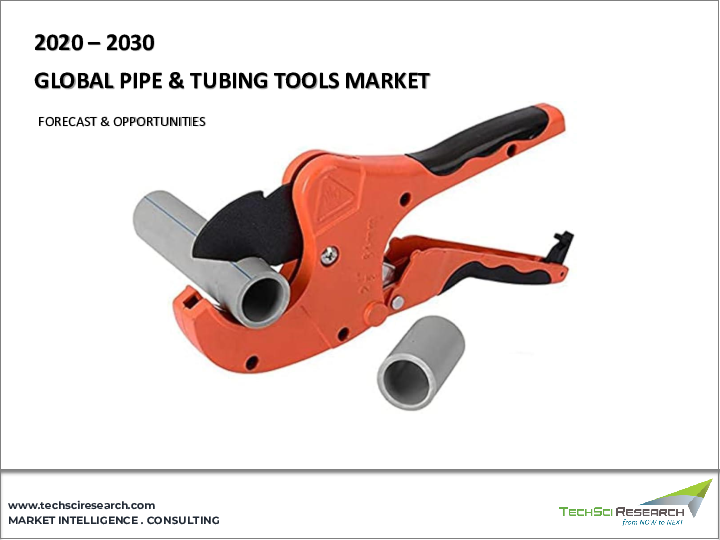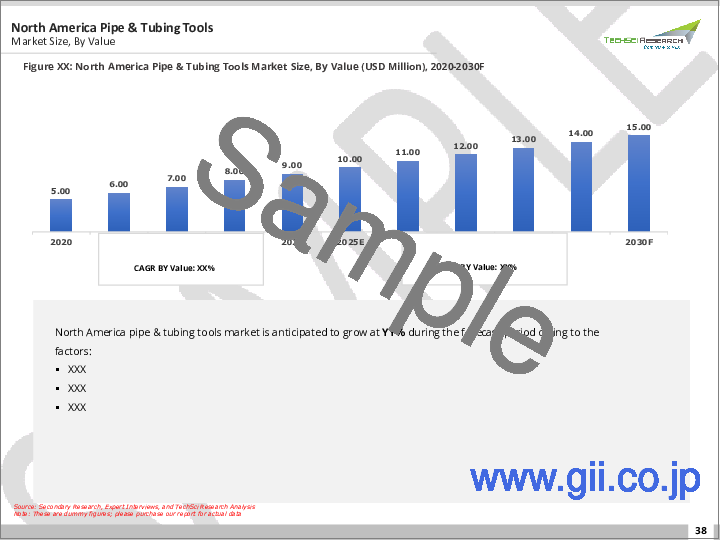|
|
市場調査レポート
商品コード
1698145
パイプ&チューブ工具市場- 世界の産業規模、シェア、動向、機会、予測、タイプ別、エンドユーザー別、地域別、競合市場別、2020-2030年Pipe & Tubing Tools Market - Global Industry Size, Share, Trends, Opportunity, and Forecast, Segmented By Type, By End-User, By Region, By Competition, 2020-2030F |
||||||
カスタマイズ可能
|
|||||||
| パイプ&チューブ工具市場- 世界の産業規模、シェア、動向、機会、予測、タイプ別、エンドユーザー別、地域別、競合市場別、2020-2030年 |
|
出版日: 2025年03月28日
発行: TechSci Research
ページ情報: 英文 186 Pages
納期: 2~3営業日
|
全表示
- 概要
- 目次
パイプ&チューブ工具の世界市場規模は、2024年に36億米ドルとなり、2030年までのCAGRは2.7%で、2030年には43億米ドルに達すると予測されています。
住宅、商業、工業プロジェクトを含む世界の建設とインフラ開発の拡大により、これらのツールの需要が大幅に増加しています。石油・ガス産業の成長も重要な役割を果たしており、探査、採掘、パイプラインの設置には効率的で耐久性のあるパイプ・チューブ工具が必要です。さらに、都市化と人口増加は、配管システムに大きく依存する上下水道やエネルギーなどの公共事業の需要拡大につながります。
| 市場概要 | |
|---|---|
| 予測期間 | 2026-2030 |
| 市場規模:2024年 | 36億米ドル |
| 市場規模:2030年 | 43億米ドル |
| CAGR:2025年~2030年 | 2.7% |
| 急成長セグメント | 配管機器 |
| 最大市場 | 北米 |
自動化やロボット工学など、工具の技術的進歩により効率が向上し、生産性と安全性の向上を目指す業界にとって魅力的なものとなっています。発電を中心としたクリーンなエネルギー源の世界の推進により、パイプ・チューブシステムと関連工具のニーズがさらに高まっています。さらに、特に化学や製薬などの業界では、既存のパイプライン・インフラのメンテナンスや修理が継続的に行われており、市場を押し上げています。また、安全性と環境への影響に関する厳しい規制基準も、特殊工具の採用を促進する一方、鉱業と化学分野の成長が継続的な需要を支えています。これらの要因が相まって、世界のパイプ・チューブ工具市場の拡大に寄与しています。
主な市場促進要因
インフラと建設プロジェクトの拡大
主な市場課題
原材料コストの上昇とサプライチェーンの混乱
主な市場動向
自動化とデジタル化の採用増加
目次
第1章 概要
第2章 調査手法
第3章 エグゼクティブサマリー
第4章 顧客の声
第5章 世界のパイプ&チューブ工具市場展望
- 市場規模・予測
- 金額別
- 市場シェア・予測
- タイプ別(配管設備、チューブ設備)
- エンドユーザー別(石油・ガス、水道・廃水、インフラ・建設、自動車、その他)
- 地域別
- 企業別(2024)
- 市場マップ
第6章 北米のパイプ&チューブ工具市場展望
- 市場規模・予測
- 市場シェア・予測
- 北米:国別分析
- 米国
- カナダ
- メキシコ
第7章 欧州のパイプ&チューブ工具市場展望
- 市場規模・予測
- 市場シェア・予測
- 欧州:国別分析
- ドイツ
- 英国
- イタリア
- フランス
- スペイン
第8章 アジア太平洋地域のパイプ&チューブ工具市場展望
- 市場規模・予測
- 市場シェア・予測
- アジア太平洋地域:国別分析
- 中国
- インド
- 日本
- 韓国
- オーストラリア
第9章 南米のパイプ&チューブ工具市場展望
- 市場規模・予測
- 市場シェア・予測
- 南米:国別分析
- ブラジル
- アルゼンチン
- コロンビア
第10章 中東・アフリカのパイプ&チューブ工具市場展望
- 市場規模・予測
- 市場シェア・予測
- 中東・アフリカ:国別分析
- 南アフリカ
- サウジアラビア
- アラブ首長国連邦
- クウェート
- トルコ
第11章 市場力学
- 促進要因
- 課題
第12章 市場動向と発展
- 合併と買収
- 製品の発売
- 最近の動向
第13章 企業プロファイル
- DWT Gmbh
- Emerson Electric Co.
- ESCO Tool Co.
- G.B.C. Industrial Tools Spa
- Illinois Tool Works Inc.
- Madison Industries
- Parker Hannifin Corp.
- Reed Manufacturing Co.
- Tectronic Industries Co. Ltd.
- JF Tools India
第14章 戦略的提言
第15章 調査会社について・免責事項
The Global Pipe & Tubing Tools Market was valued at USD 3.6 billion in 2024 and is expected to reach USD 4.3 billion by 2030 with a CAGR of 2.7% through 2030. The expanding construction and infrastructure development globally, including residential, commercial, and industrial projects, significantly increases the demand for these tools. The growing oil and gas industry also plays a crucial role, as exploration, extraction, and pipeline installations require efficient and durable pipe and tubing tools. Additionally, urbanization and population growth lead to greater demand for utilities like water, sewage, and energy, which rely heavily on piping systems.
| Market Overview | |
|---|---|
| Forecast Period | 2026-2030 |
| Market Size 2024 | USD 3.6 Billion |
| Market Size 2030 | USD 4.3 Billion |
| CAGR 2025-2030 | 2.7% |
| Fastest Growing Segment | Piping Equipment |
| Largest Market | North America |
Technological advancements in tools, including automation and robotics, enhance their efficiency, making them more attractive to industries looking to improve productivity and safety. The global push for cleaner energy sources, especially in power generation, further increases the need for pipe and tubing systems and related tools. Moreover, the ongoing maintenance and repair of existing pipeline infrastructure, especially in industries like chemicals and pharmaceuticals, boosts the market. Strict regulatory standards for safety and environmental impact also drive the adoption of specialized tools, while the growth of the mining and chemical sectors supports continuous demand. Together, these drivers contribute to the expansion of the global pipe and tubing tools market.
Key Market Drivers
Expansion of Infrastructure and Construction Projects
The growing demand for pipes and tubing tools is primarily driven by the rapid expansion of infrastructure and construction projects across the globe. As urbanization increases, particularly in developing countries, the need for reliable piping systems in residential, commercial, and industrial structures has surged. Urban growth leads to a rise in construction activities, with new buildings, highways, bridges, and industrial plants requiring substantial pipeline systems for water, sewage, energy, and gas distribution. In addition, the construction of renewable energy plants, such as solar and wind farms, necessitates advanced pipe and tubing tools to ensure the effective transportation of fluids, gases, and other materials. This ongoing demand for construction materials and systems creates an essential market for pipe and tubing tools that are required for efficient installation, maintenance, and repair. In January 2025, a Bay County-based pipe manufacturer unveiled a USD 68 million investment in advanced technology aimed at improving steel pipe production. This initiative focuses on incorporating innovative techniques to form steel pipes by transforming flat metal sheets through a structured three-step process.
Key Market Challenges
Rising Raw Material Costs and Supply Chain Disruptions
One of the key challenges faced by the global pipe and tubing tools market is the fluctuating costs of raw materials, which directly impacts production costs and profitability. The raw materials required for manufacturing pipe and tubing tools, such as high-grade steel, alloys, and specialized coatings, are subject to global supply and demand pressures. Economic instability, geopolitical tensions, and trade restrictions often lead to price volatility for these critical materials. For instance, shortages in steel or specific metals required for durable tubing tools can result in supply chain delays or increased production costs, which are subsequently passed on to consumers. These cost hikes affect manufacturers' ability to offer competitively priced products, which is particularly challenging in price-sensitive markets.
Key Market Trends
Increasing Adoption of Automation and Digitalization
A major trend in the Global Pipe & Tubing Tools Market is the increasing adoption of automation and digitalization across the industry. As industries seek to improve efficiency, reduce operational costs, and enhance safety, automation is becoming a critical component of the manufacturing and application of pipe and tubing tools. Automated systems such as robotic welding machines, automated pipe threading tools, and computer-controlled machinery are being increasingly integrated into production lines to streamline the process. This automation not only speeds up manufacturing but also ensures higher precision and consistency in the quality of the tools produced, making them more reliable for high-performance applications in sectors like oil and gas, chemical processing, and construction.
In addition to manufacturing, digitalization is transforming how pipe and tubing tools are used in the field. The incorporation of Internet of Things (IoT) technology, sensors, and cloud-based platforms allows for real-time monitoring of pipeline systems and predictive maintenance. These tools can detect potential issues before they lead to failures, reducing downtime and maintenance costs. For example, smart sensors embedded in pipes can track pressure, temperature, and flow, sending data to maintenance teams for analysis. The integration of digital tools in pipe and tubing systems is enabling industries to improve their overall operational efficiency, safety, and cost-effectiveness. Moreover, digitalization is also aiding in remote diagnostics and troubleshooting, which is especially valuable in hazardous environments like offshore oil rigs or deep underground pipelines. This trend towards automation and digitalization is reshaping the pipe and tubing tools market, driving demand for advanced, high-tech tools that improve operational outcomes.
Key Market Players
- DWT Gmbh
- Emerson Electric Co.
- ESCO Tool Co.
- G.B.C. Industrial Tools Spa
- Illinois Tool Works Inc.
- Madison Industries
- Parker Hannifin Corp.
- Reed Manufacturing Co.
- Tectronic Industries Co. Ltd.
- JF Tools India
Report Scope:
In this report, the Global Pipe & Tubing Tools Market has been segmented into the following categories, in addition to the industry trends which have also been detailed below:
Pipe & Tubing Tools Market, By Type:
- Piping Equipment
- Tubing Equipment
Pipe & Tubing Tools Market, By End-User:
- Oil & Gas
- Water & Wastewater
- Infrastructure and Construction
- Automotive
- Others
Pipe & Tubing Tools Market, By Region:
- North America
- United States
- Canada
- Mexico
- Europe
- Germany
- France
- United Kingdom
- Italy
- Spain
- Asia Pacific
- China
- India
- Japan
- South Korea
- Australia
- South America
- Brazil
- Colombia
- Argentina
- Middle East & Africa
- Saudi Arabia
- UAE
- South Africa
- Turkey
- Kuwait
Competitive Landscape
Company Profiles: Detailed analysis of the major companies present in the Global Pipe & Tubing Tools Market.
Available Customizations:
Global Pipe & Tubing Tools Market report with the given market data, Tech Sci Research offers customizations according to a company's specific needs. The following customization options are available for the report:
Company Information
- Detailed analysis and profiling of additional market players (up to five).
Table of Contents
1. Product Overview
- 1.1. Market Definition
- 1.2. Scope of the Market
- 1.2.1. Markets Covered
- 1.2.2. Years Considered for Study
- 1.3. Key Market Segmentations
2. Research Methodology
- 2.1. Objective of the Study
- 2.2. Baseline Methodology
- 2.3. Formulation of the Scope
- 2.4. Assumptions and Limitations
- 2.5. Sources of Research
- 2.5.1. Secondary Research
- 2.5.2. Primary Research
- 2.6. Approach for the Market Study
- 2.6.1. The Bottom-Up Approach
- 2.6.2. The Top-Down Approach
- 2.7. Methodology Followed for Calculation of Market Size & Market Shares
- 2.8. Forecasting Methodology
- 2.8.1. Data Triangulation & Validation
3. Executive Summary
- 3.1. Overview of the Market
- 3.2. Overview of Key Market Segmentations
- 3.3. Overview of Key Market Players
- 3.4. Overview of Key Regions/Countries
- 3.5. Overview of Market Drivers, Challenges, and Trends
4. Voice of Customer
5. Global Pipe & Tubing Tools Market Outlook
- 5.1. Market Size & Forecast
- 5.1.1. By Value
- 5.2. Market Share & Forecast
- 5.2.1. By Type (Piping Equipment, Tubing Equipment)
- 5.2.2. By End-User (Oil & Gas, Water & Wastewater, Infrastructure and Construction, Automotive, Others)
- 5.2.3. By Region
- 5.3. By Company (2024)
- 5.4. Market Map
6. North America Pipe & Tubing Tools Market Outlook
- 6.1. Market Size & Forecast
- 6.1.1. By Value
- 6.2. Market Share & Forecast
- 6.2.1. By Type
- 6.2.2. By End-User
- 6.2.3. By Country
- 6.3. North America: Country Analysis
- 6.3.1. United States Pipe & Tubing Tools Market Outlook
- 6.3.1.1. Market Size & Forecast
- 6.3.1.1.1. By Value
- 6.3.1.2. Market Share & Forecast
- 6.3.1.2.1. By Type
- 6.3.1.2.2. By End-User
- 6.3.1.1. Market Size & Forecast
- 6.3.2. Canada Pipe & Tubing Tools Market Outlook
- 6.3.2.1. Market Size & Forecast
- 6.3.2.1.1. By Value
- 6.3.2.2. Market Share & Forecast
- 6.3.2.2.1. By Type
- 6.3.2.2.2. By End-User
- 6.3.2.1. Market Size & Forecast
- 6.3.3. Mexico Pipe & Tubing Tools Market Outlook
- 6.3.3.1. Market Size & Forecast
- 6.3.3.1.1. By Value
- 6.3.3.2. Market Share & Forecast
- 6.3.3.2.1. By Type
- 6.3.3.2.2. By End-User
- 6.3.3.1. Market Size & Forecast
- 6.3.1. United States Pipe & Tubing Tools Market Outlook
7. Europe Pipe & Tubing Tools Market Outlook
- 7.1. Market Size & Forecast
- 7.1.1. By Value
- 7.2. Market Share & Forecast
- 7.2.1. By Type
- 7.2.2. By End-User
- 7.2.3. By Country
- 7.3. Europe: Country Analysis
- 7.3.1. Germany Pipe & Tubing Tools Market Outlook
- 7.3.1.1. Market Size & Forecast
- 7.3.1.1.1. By Value
- 7.3.1.2. Market Share & Forecast
- 7.3.1.2.1. By Type
- 7.3.1.2.2. By End-User
- 7.3.1.1. Market Size & Forecast
- 7.3.2. United Kingdom Pipe & Tubing Tools Market Outlook
- 7.3.2.1. Market Size & Forecast
- 7.3.2.1.1. By Value
- 7.3.2.2. Market Share & Forecast
- 7.3.2.2.1. By Type
- 7.3.2.2.2. By End-User
- 7.3.2.1. Market Size & Forecast
- 7.3.3. Italy Pipe & Tubing Tools Market Outlook
- 7.3.3.1. Market Size & Forecast
- 7.3.3.1.1. By Value
- 7.3.3.2. Market Share & Forecast
- 7.3.3.2.1. By Type
- 7.3.3.2.2. By End-User
- 7.3.3.1. Market Size & Forecast
- 7.3.4. France Pipe & Tubing Tools Market Outlook
- 7.3.4.1. Market Size & Forecast
- 7.3.4.1.1. By Value
- 7.3.4.2. Market Share & Forecast
- 7.3.4.2.1. By Type
- 7.3.4.2.2. By End-User
- 7.3.4.1. Market Size & Forecast
- 7.3.5. Spain Pipe & Tubing Tools Market Outlook
- 7.3.5.1. Market Size & Forecast
- 7.3.5.1.1. By Value
- 7.3.5.2. Market Share & Forecast
- 7.3.5.2.1. By Type
- 7.3.5.2.2. By End-User
- 7.3.5.1. Market Size & Forecast
- 7.3.1. Germany Pipe & Tubing Tools Market Outlook
8. Asia-Pacific Pipe & Tubing Tools Market Outlook
- 8.1. Market Size & Forecast
- 8.1.1. By Value
- 8.2. Market Share & Forecast
- 8.2.1. By Type
- 8.2.2. By End-User
- 8.2.3. By Country
- 8.3. Asia-Pacific: Country Analysis
- 8.3.1. China Pipe & Tubing Tools Market Outlook
- 8.3.1.1. Market Size & Forecast
- 8.3.1.1.1. By Value
- 8.3.1.2. Market Share & Forecast
- 8.3.1.2.1. By Type
- 8.3.1.2.2. By End-User
- 8.3.1.1. Market Size & Forecast
- 8.3.2. India Pipe & Tubing Tools Market Outlook
- 8.3.2.1. Market Size & Forecast
- 8.3.2.1.1. By Value
- 8.3.2.2. Market Share & Forecast
- 8.3.2.2.1. By Type
- 8.3.2.2.2. By End-User
- 8.3.2.1. Market Size & Forecast
- 8.3.3. Japan Pipe & Tubing Tools Market Outlook
- 8.3.3.1. Market Size & Forecast
- 8.3.3.1.1. By Value
- 8.3.3.2. Market Share & Forecast
- 8.3.3.2.1. By Type
- 8.3.3.2.2. By End-User
- 8.3.3.1. Market Size & Forecast
- 8.3.4. South Korea Pipe & Tubing Tools Market Outlook
- 8.3.4.1. Market Size & Forecast
- 8.3.4.1.1. By Value
- 8.3.4.2. Market Share & Forecast
- 8.3.4.2.1. By Type
- 8.3.4.2.2. By End-User
- 8.3.4.1. Market Size & Forecast
- 8.3.5. Australia Pipe & Tubing Tools Market Outlook
- 8.3.5.1. Market Size & Forecast
- 8.3.5.1.1. By Value
- 8.3.5.2. Market Share & Forecast
- 8.3.5.2.1. By Type
- 8.3.5.2.2. By End-User
- 8.3.5.1. Market Size & Forecast
- 8.3.1. China Pipe & Tubing Tools Market Outlook
9. South America Pipe & Tubing Tools Market Outlook
- 9.1. Market Size & Forecast
- 9.1.1. By Value
- 9.2. Market Share & Forecast
- 9.2.1. By Type
- 9.2.2. By End-User
- 9.2.3. By Country
- 9.3. South America: Country Analysis
- 9.3.1. Brazil Pipe & Tubing Tools Market Outlook
- 9.3.1.1. Market Size & Forecast
- 9.3.1.1.1. By Value
- 9.3.1.2. Market Share & Forecast
- 9.3.1.2.1. By Type
- 9.3.1.2.2. By End-User
- 9.3.1.1. Market Size & Forecast
- 9.3.2. Argentina Pipe & Tubing Tools Market Outlook
- 9.3.2.1. Market Size & Forecast
- 9.3.2.1.1. By Value
- 9.3.2.2. Market Share & Forecast
- 9.3.2.2.1. By Type
- 9.3.2.2.2. By End-User
- 9.3.2.1. Market Size & Forecast
- 9.3.3. Colombia Pipe & Tubing Tools Market Outlook
- 9.3.3.1. Market Size & Forecast
- 9.3.3.1.1. By Value
- 9.3.3.2. Market Share & Forecast
- 9.3.3.2.1. By Type
- 9.3.3.2.2. By End-User
- 9.3.3.1. Market Size & Forecast
- 9.3.1. Brazil Pipe & Tubing Tools Market Outlook
10. Middle East and Africa Pipe & Tubing Tools Market Outlook
- 10.1. Market Size & Forecast
- 10.1.1. By Value
- 10.2. Market Share & Forecast
- 10.2.1. By Type
- 10.2.2. By End-User
- 10.2.3. By Country
- 10.3. Middle East and Africa: Country Analysis
- 10.3.1. South Africa Pipe & Tubing Tools Market Outlook
- 10.3.1.1. Market Size & Forecast
- 10.3.1.1.1. By Value
- 10.3.1.2. Market Share & Forecast
- 10.3.1.2.1. By Type
- 10.3.1.2.2. By End-User
- 10.3.1.1. Market Size & Forecast
- 10.3.2. Saudi Arabia Pipe & Tubing Tools Market Outlook
- 10.3.2.1. Market Size & Forecast
- 10.3.2.1.1. By Value
- 10.3.2.2. Market Share & Forecast
- 10.3.2.2.1. By Type
- 10.3.2.2.2. By End-User
- 10.3.2.1. Market Size & Forecast
- 10.3.3. UAE Pipe & Tubing Tools Market Outlook
- 10.3.3.1. Market Size & Forecast
- 10.3.3.1.1. By Value
- 10.3.3.2. Market Share & Forecast
- 10.3.3.2.1. By Type
- 10.3.3.2.2. By End-User
- 10.3.3.1. Market Size & Forecast
- 10.3.4. Kuwait Pipe & Tubing Tools Market Outlook
- 10.3.4.1. Market Size & Forecast
- 10.3.4.1.1. By Value
- 10.3.4.2. Market Share & Forecast
- 10.3.4.2.1. By Type
- 10.3.4.2.2. By End-User
- 10.3.4.1. Market Size & Forecast
- 10.3.5. Turkey Pipe & Tubing Tools Market Outlook
- 10.3.5.1. Market Size & Forecast
- 10.3.5.1.1. By Value
- 10.3.5.2. Market Share & Forecast
- 10.3.5.2.1. By Type
- 10.3.5.2.2. By End-User
- 10.3.5.1. Market Size & Forecast
- 10.3.1. South Africa Pipe & Tubing Tools Market Outlook
11. Market Dynamics
- 11.1. Drivers
- 11.2. Challenges
12. Market Trends & Developments
- 12.1. Merger & Acquisition (If Any)
- 12.2. Product Launches (If Any)
- 12.3. Recent Developments
13. Company Profiles
- 13.1. DWT Gmbh
- 13.1.1. Business Overview
- 13.1.2. Key Revenue and Financials
- 13.1.3. Recent Developments
- 13.1.4. Key Personnel/Key Contact Person
- 13.1.5. Key Product/Services Offered
- 13.2. Emerson Electric Co.
- 13.3. ESCO Tool Co.
- 13.4. G.B.C. Industrial Tools Spa
- 13.5. Illinois Tool Works Inc.
- 13.6. Madison Industries
- 13.7. Parker Hannifin Corp.
- 13.8. Reed Manufacturing Co.
- 13.9. Tectronic Industries Co. Ltd.
- 13.10. JF Tools India





